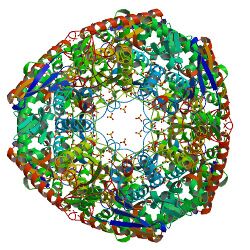Biology:Polynucleotide phosphorylase
| Polynucleotide Phosphorylase | |||||||||
|---|---|---|---|---|---|---|---|---|---|
 | |||||||||
| Identifiers | |||||||||
| EC number | 2.7.7.8 | ||||||||
| CAS number | 9014-12-4 | ||||||||
| Databases | |||||||||
| IntEnz | IntEnz view | ||||||||
| BRENDA | BRENDA entry | ||||||||
| ExPASy | NiceZyme view | ||||||||
| KEGG | KEGG entry | ||||||||
| MetaCyc | metabolic pathway | ||||||||
| PRIAM | profile | ||||||||
| PDB structures | RCSB PDB PDBe PDBsum | ||||||||
| Gene Ontology | AmiGO / QuickGO | ||||||||
| |||||||||
Polynucleotide Phosphorylase (PNPase) is a bifunctional enzyme with a phosphorolytic 3' to 5' exoribonuclease activity and a 3'-terminal oligonucleotide polymerase activity.[2] That is, it dismantles the RNA chain starting at the 3' end and working toward the 5' end.[1] It also synthesizes long, highly heteropolymeric tails in vivo. It accounts for all of the observed residual polyadenylation in strains of Escherichia coli missing the normal polyadenylation enzyme.[1] Discovered by Marianne Grunberg-Manago working in Severo Ochoa's lab in 1955, the RNA-polymerization activity of PNPase was initially believed to be responsible for DNA-dependent synthesis of messenger RNA, a notion that was disproven by the late 1950s.[3][4]
It is involved in mRNA processing and degradation in bacteria, plants,[5] and animals.[6]
In humans, the enzyme is encoded by the PNPT1 gene. In its active form, the protein forms a ring structure consisting of three PNPase molecules. Each PNPase molecule consists of two RNase PH domains, an S1 RNA binding domain and a K-homology domain. The protein is present in bacteria and in the chloroplasts[2] and mitochondria[7] of some eukaryotic cells. In eukaryotes and archaea, a structurally and evolutionary related complex exists, called the exosome complex.[7]
The same abbreviation (PNPase) is also used for another, otherwise unrelated enzyme, Purine nucleoside phosphorylase.
| Human PNPase I | |
|---|---|
| Identifiers | |
| Symbol | PNPASE |
| Alt. symbols | PNPase, OLD35, old-35 |
| NCBI gene | 87178 |
| HGNC | 23166 |
| OMIM | 610316 |
| PDB | 1E3P |
| RefSeq | NM_033109 |
| UniProt | Q8TCS8 |
| Other data | |
| EC number | 2.7.7.8 |
| Locus | Chr. 2 p15 |
References
- ↑ 1.0 1.1 1.2 "A duplicated fold is the structural basis for polynucleotide phosphorylase catalytic activity, processivity, and regulation". Structure 8 (11): 1215–26. November 2000. doi:10.1016/S0969-2126(00)00521-9. PMID 11080643.
- ↑ 2.0 2.1 "Polynucleotide phosphorylase functions as both an exonuclease and a poly(A) polymerase in spinach chloroplasts". Molecular and Cellular Biology 21 (16): 5408–16. August 2001. doi:10.1128/MCB.21.16.5408-5416.2001. PMID 11463823.
- ↑ "Enzymic synthesis of polynucleotides. I. Polynucleotide phosphorylase of azotobacter vinelandii". Biochimica et Biophysica Acta 20 (1): 269–85. April 1956. doi:10.1016/0006-3002(56)90286-4. PMID 13315374.
- ↑ "The role of deoxyribonucleic acid in ribonucleic acid synthesis. I. The purification and properties of ribonucleic acid polymerase". The Journal of Biological Chemistry 237 (8): 2611–9. August 1962. doi:10.1016/S0021-9258(19)73796-X. PMID 13895983. http://www.jbc.org/content/281/15/e12.full.pdf.
- ↑ "Integration of chloroplast nucleic acid metabolism into the phosphate deprivation response in Chlamydomonas reinhardtii". The Plant Cell 19 (3): 1023–38. March 2007. doi:10.1105/tpc.106.045427. PMID 17351118.
- ↑ "Human polynucleotide phosphorylase (hPNPase old-35): an RNA degradation enzyme with pleiotrophic biological effects". Cell Cycle 5 (10): 1080–4. May 2006. doi:10.4161/cc.5.10.2741. PMID 16687933. http://www.landesbioscience.com/journals/cc/article/sarkarCC5-10.pdf.
- ↑ 7.0 7.1 Cell and molecular biology of the exosome: how to make or break an RNA. International Review of Cytology. 251. 2006. pp. 159–208. doi:10.1016/S0074-7696(06)51005-8. ISBN 9780123646552.
External links
- Polynucleotide+Phosphorylase at the US National Library of Medicine Medical Subject Headings (MeSH)
 |

